
A Winter Visit to the South Coast of Iceland- all the way to Jökulsárlón Glacial Lagoon

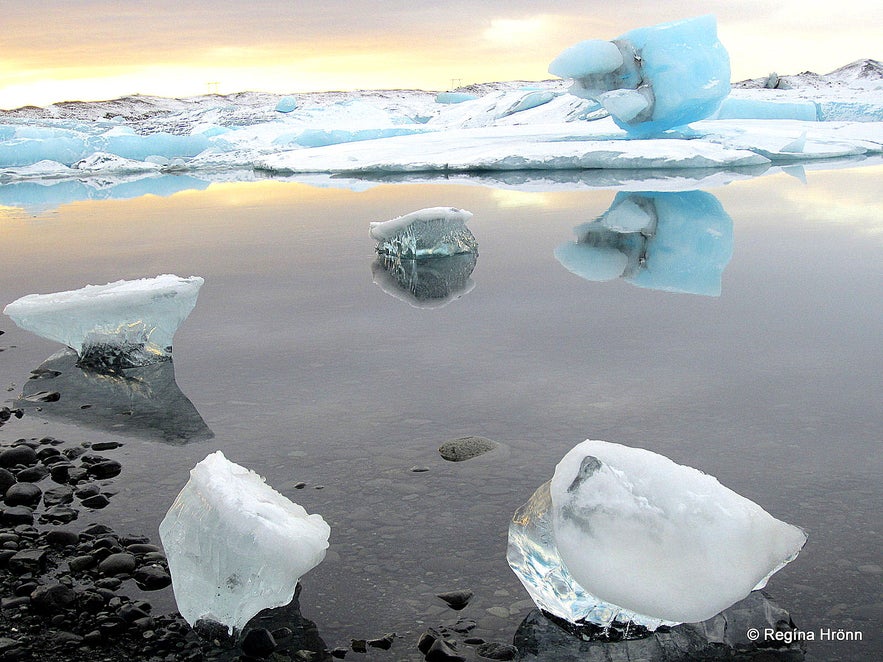
I rarely travel in Iceland in the wintertime; I use the summers for travelling and the winters for writing. But now that I am reading news articles about cars flying off the icy roads or getting stuck in blizzards I want to tell you about one winter tour a couple of years ago.
I guided 2 sisters, friends of mine from Slovenia, from Reykjavík all the way to Jökulsárlón glacial lagoon in freezing November temperatures.
Top photo: Jökulsárlón glacial lagoon
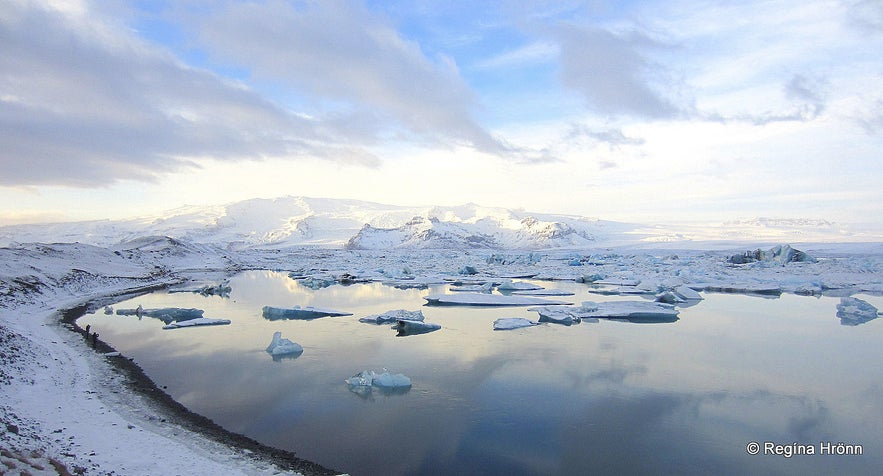
Jökulsárlón glacial lagoon
This was back in 2013 and since then, in the 280 travel-blogs I have by now written, I almost solely show you what it is like travelling in Iceland in the summertime. My purpose in writing this winter travel-blog is to show you winter photos of the same locations and what Iceland might look like in the wintertime.
And to warn you about the dangers you can encounter when driving on icy roads in wintertime. Visiting Iceland in December f.ex. can mean that we have blizzards and road closures so that you might not be able to reach your destination so take that into account when planning a winter trip to Iceland.
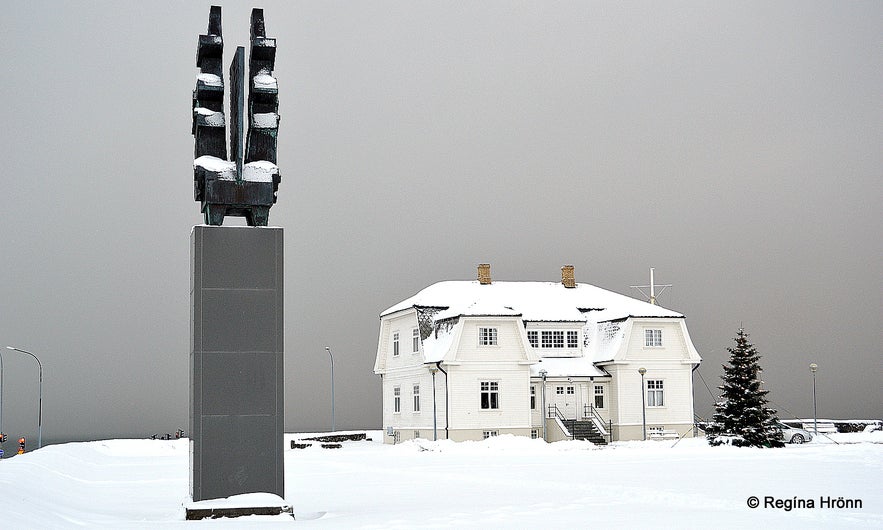 Höfði in Reykjavík - a blizzard approaching
Höfði in Reykjavík - a blizzard approaching
December 2022 was especially difficult in this regard, with frequent road closures all around the country. And the busiest roads on the south coast and to the airport were closed for days due to blizzards and extreme amounts of snow.
A couple of years ago very few people visited Iceland in wintertime, so there are almost no people in my photos. In only a couple of places, we saw a couple of people. How things have changed in Iceland in only a few years.
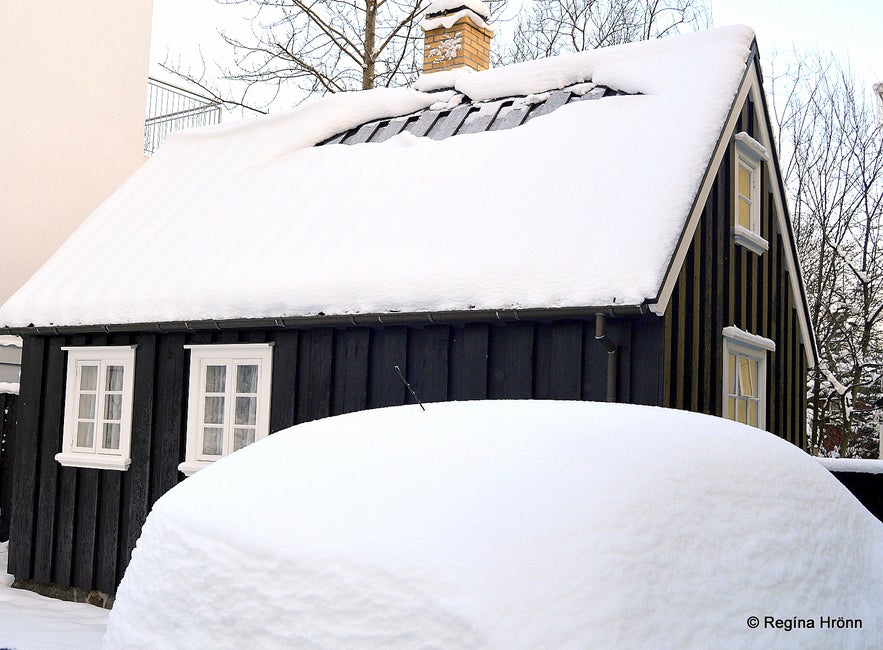 Beneath the heap of snow is a car!
Beneath the heap of snow is a car!
Now visitors have started flocking to Iceland in the wintertime to enjoy the Northern Lights, the ice caves, and the snow.
But it also means that you can be stuck in a blizzard with very difficult driving conditions and zero visibility.
Now let me show you what a winter visit to the south coast of Iceland might be like:

The roads were icy and snowy
The sisters I was guiding rented a car and I told them to ask for a 4x4 car with good studded tires for a better grip. It was not a mistake as on the icy roads were small 2x2 cars driving very slowly (30 km/h) and some were spinning off the road as it was also very windy!
Be aware that these might be the conditions on Icelandic roads in wintertime. The speed limit on the highway is 90 km/h under the best circumstances, but not on slippery roads. And then take into account possible sudden gusts.

Snowy roads in South-Iceland
The Icelandic police has started worrying about tourists, who are not used to driving on icy roads, speeding, and getting themselves and other drivers into trouble. For the first 5-6 weeks of the year 2019, the South Iceland police counted some 106 reported road accidents with drivers overturning their cars, cars spinning off the road, and car crashes!
The winter traffic in South-Iceland has increased considerably in the past couple of years. The daily winter traffic for the south coast to Vík is around 1,600 cars and further than Vík, i.e. to Jökulsárlón glacial lagoon and Höfn the winter traffic is around 800 cars.
You can see photos in the news article in Iceland Monitor here below:
The Police worried about Tourists driving in South-Iceland
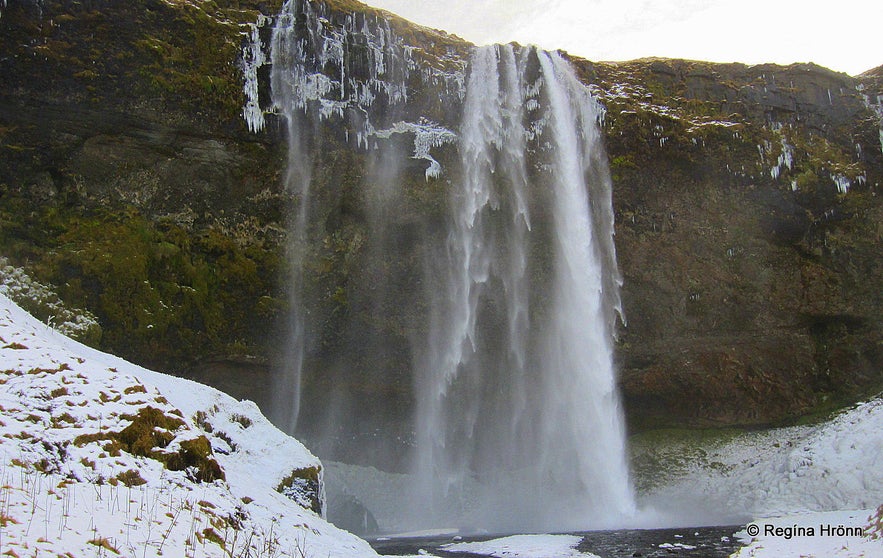
Seljalandsfoss waterfall
Our first stop was at Seljalandsfoss and Gljúfrabúi, which are two beautiful waterfalls at a distance of some 120 km from Reykjavík. These waterfalls are almost by the road and easily accessible. In the summertime, you can walk behind Seljalandsfoss, but in wintertime, the path is often closed as it gets too slippery and dangerous.
Notice the icicles in the cliffs in the video below, which I shot during our visit.
Icicles (grýlukerti) can be deadly here when they fall on the path. A friend of mine, Jórunn Rothenberg, who runs My Iceland Guide, was guiding a group on the south coast in wintertime. She stopped by Seljalandsfoss and told the group not to go behind the waterfall as it was too dangerous.
Several people from the group disobeyed and went ahead and one woman barely escaped alive when a rumble was heard and a huge icicle fell right in front of her; with ice splashing on her, even down the back of her neck!
Had she gone one step further she would not have survived. That is why the path is closed; for safety. So never cross the line if it is closed.
The news report I add here from this incident is in Icelandic, but you can see the icy conditions by Seljalandsfoss in the first 2 minutes of the following video:
News report on a huge icicle falling on a tourist
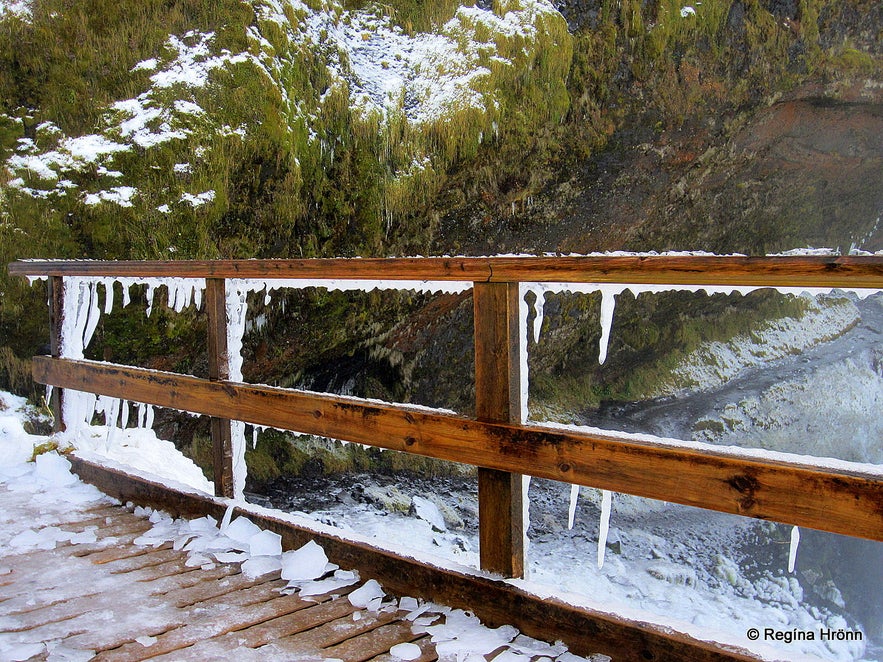
This is what the path can look like in the wintertime
We, locals, know about the dangers in our country and think it is common sense not to risk our lives under such circumstances, but in many instances, all caution seems to be thrown to the wind when people are visiting a new country.
It is not stupidity, as so many people call it, but being oblivious to the dangers of a foreign country, and being very excited about seeing new things. Especially if one daredevil disobeys the guides then people seem to follow suit. Please don't do it, it is not worth losing your life for.
I have written a travel-blog on the waterfalls on the south coast where you can see what they look like in the summertime.
The beautiful Waterfalls of South Iceland; Seljalandsfoss, Skógafoss & Gljúfrabúi
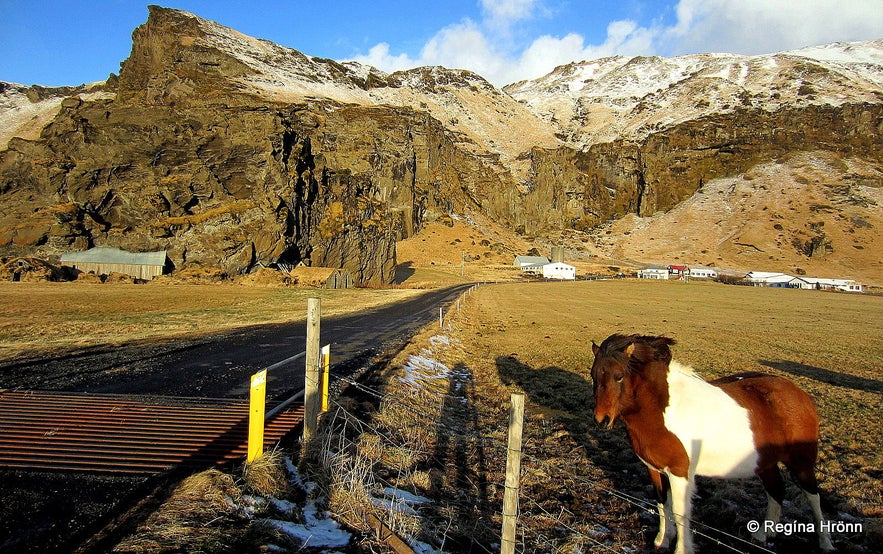
Horses by Drangshlíð farm
I have noticed that most foreign travellers like to stop when they see the Icelandic horses, to pet them and take photos. And so did we. Just don't feed them bread even though they beg for it, it doesn't agree with them, the local farmers tell us.
We stopped by Drangshlíð farm and took some photos of the horses in their winter attire. They, of course, wanted to be fed so they approached us, looking disappointed when we just wanted to pet them and take photos. It was so windy here that one of the sisters slipped on the ice and fell flat down on her back.
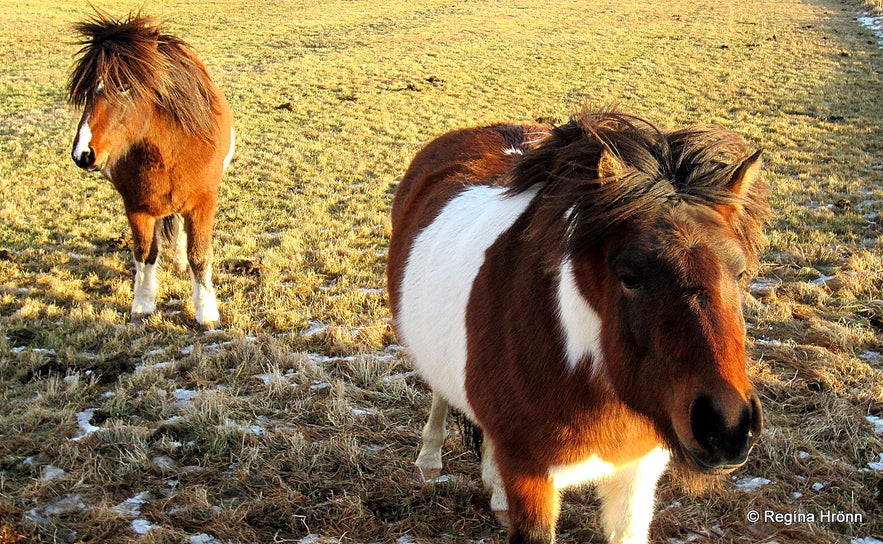
Icelandic horses in their winter coat, as it were
Horse riding tours are very popular in Iceland. Just remember that these Viking horses are not ponies, but sturdy stallions. So never refer to them as ponies, it will offend both them and the Icelanders ;) If you want to try riding Icelandic horses then we have many horse riding tours in Iceland:
This location, Drangshlíð, is both a farm and a guesthouse. But the huge rock on their land is the home of elves and in Icelandic folklore, I found many elf-stories, which I told you about in another travel-blog:
Drangurinn in Drangshlíð and the Elves in South Iceland - Icelandic Folklore

Skógafoss waterfall
Some 30 km further east of Seljalandsfoss on ring road 1, we arrived at the majestic Skógafoss waterfall. Together these 2 beautiful waterfalls are the most popular natural sights here on the south coast of Iceland. There are many, many other beautiful sights here though.
Skógafoss is my favourite waterfall in Iceland. It is 60 m high and 25 m wide and often sports a double rainbow. We were in luck that the sun showed up and we got a faint rainbow. By Skógafoss I have even stood inside a whole circle of a rainbow! I have written a special travel-blog on Skógafoss, where you can see beautiful summer photos.
The spectacular Skógafoss Waterfall in South Iceland and the Legend of the Treasure Chest

Kvernufoss waterfall
We walked up all the steps by Skógafoss waterfall in the strong wind and frost to see it from above. I also showed the sisters the less-visited neighbour of Skógafoss, Kvernufoss, the waterfall in the gorge.
Back then (2013) nobody was visiting Kvernufoss and it wasn't until I wrote a travel-blog about this waterfall a couple of years ago that visitors started flocking there. It is well worth a visit, but it is not possible to walk behind it in wintertime.
The path is too slippery and there are icicles in the rocks. And we know by now that these sharp icicles can fall down! You can see the icicles in my video, which I took during our visit.
We were sitting quietly in front of the waterfall, enjoying it when all of a sudden a whirlwind appeared out of nowhere making Kvernufoss triple in size, so we took off, a bit frightened, and hurried back.
We for sure did not want to get wet in these freezing temperatures.
Kvernufoss Waterfall - the less visited Neighbour of Skógafoss in South-Iceland
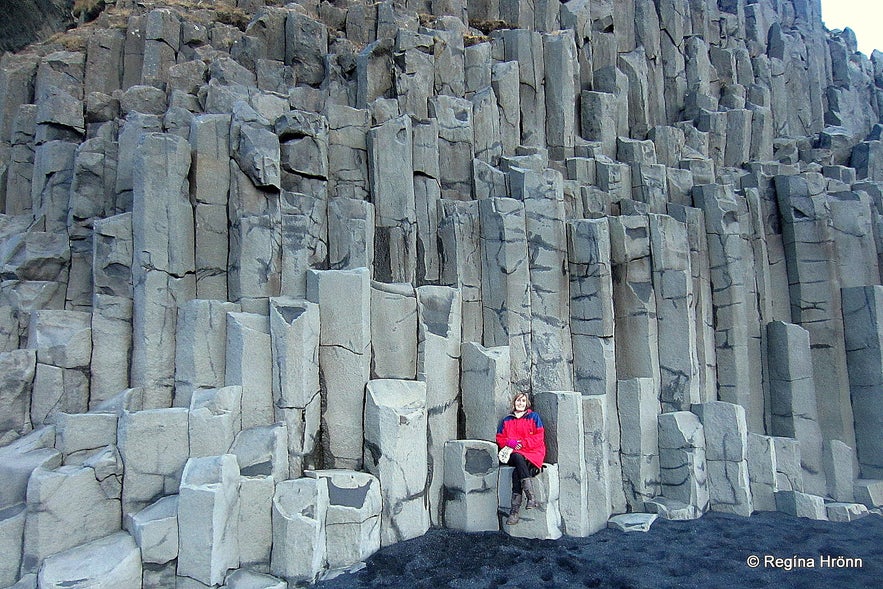
By the basalt columns at Reynisfjara beach
The next stop was Reynisfjara beach, one of the most dangerous yet beautiful beaches in Iceland, with basalt columns and magnificent, and deadly, waves. We stayed well away from the waves so as not to get pulled out by these dreadful sneaker waves.
And even if the sneaker waves won't reach us then standing too close to the ice-cold waves of the Atlantic ocean can make you drenched, and that can be very serious in freezing winter temperatures. So always keep at a safe distance from the waves. I have written a detailed travel-blog about the dangers of the sneaker waves at Reynisfjara:
Extremely dangerous Waves by Reynisfjara and Kirkjufjara black Beaches in South Iceland!
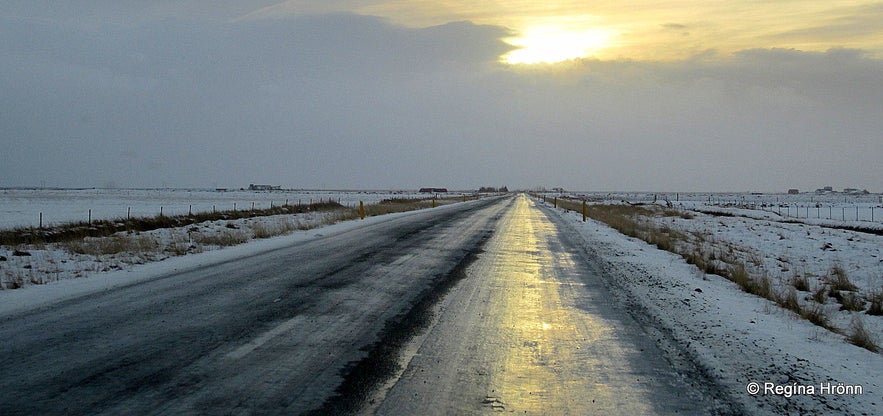
Icy roads and darkness in South-Iceland
Seeing that daylight is scarce in November in Iceland I called ahead and rented a cottage at Geirland at Kirkjubæjarklaustur village. When visiting Jökulsárlón glacial lagoon in wintertime, always stay for at least 1 night.
By now it was getting so dark that we just drove all the way to Kirkjubæjarklaustur village without stopping.
We had a lovely stay at Geirland, but back then it sufficed just calling ahead when we were on the road to book a room. Nowadays, with increased traffic on the road, you have to book way ahead of time.
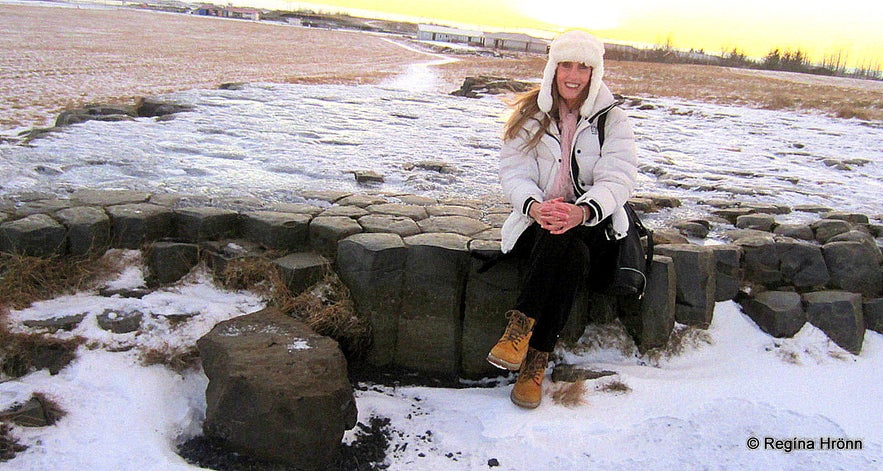
Kirkjugólfið - the Church floor
The next morning we visited Kirkjugólfið - the Church floor in Kirkjubæjarklaustur, which looks like it is a man-made floor of some sort. But it is the artwork of nature; 80 square meters of basalt column stones. It was largely covered with ice and snow during our visit.
Stjórnarfoss waterfall was frozen solid, so we only admired it from the car, but checked out Systrafoss waterfall at -10 degrees C and the red and golden rays of the morning winter sun. We were so lucky that the sun again appeared between the clouds.
But it was so cold and windy that it was difficult holding the camera.
The Historic Kirkjubæjarklaustur, Systrafoss & Systrastapi in South-Iceland

Foss á Síðu
Some 10 km east of Kirkjubæjarklaustur you will see Foss á Síðu or Foss at Síða waterfall, which I think is equally beautiful in the summertime and in wintertime. It is located right by ring-road 1.
We also stopped at Dverghamrar, the cliffs where the dwarves reside. Here you will find beautiful basalt column cliffs, which are very close to the road but cannot be seen from the road.
There aren't many places in Iceland connected to the dwarves, whereas there is a myriad of stories in our folklore, which tell us about the elves. So it is well worth stopping by the Cliffs of the Dwarves; just remember to tread lightly and show respect.
Extraordinary Columnar Basalt and Waterfalls in South Iceland - Foss á Síðu & Dverghamrar
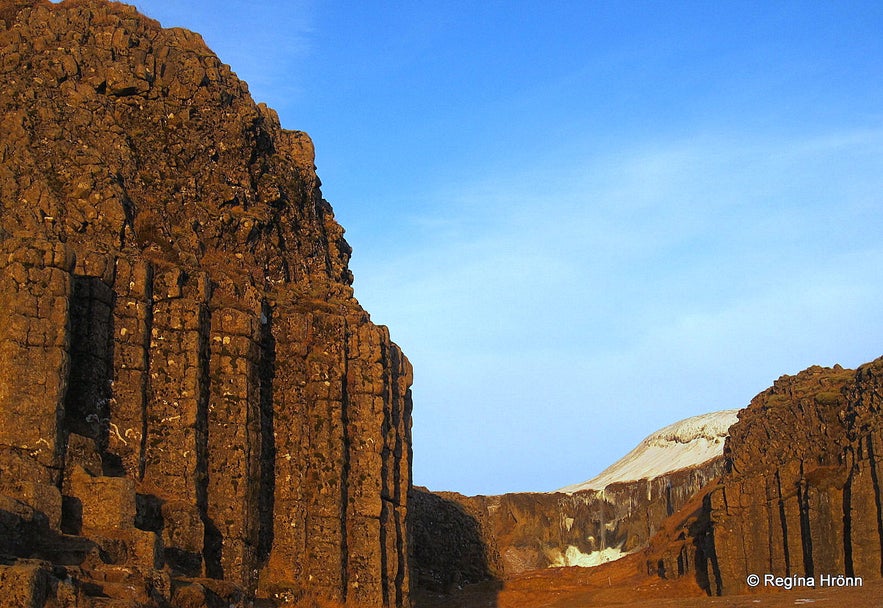
Dverghamrar and Foss á Síðu
Never exceed the speed limit which is 90 km/h on ring-road 1 under the best driving conditions. Icy and slippery roads and bridges are not the best driving conditions so you have to stay under that speed limit.
It is a well-known fact that the road conditions on the south coast can change rapidly in wintertime; there might be no ice, but after a short while, the road is icy again. And then the wind can blow cars off the road.
Also, be very careful when you cross one-lane bridges.
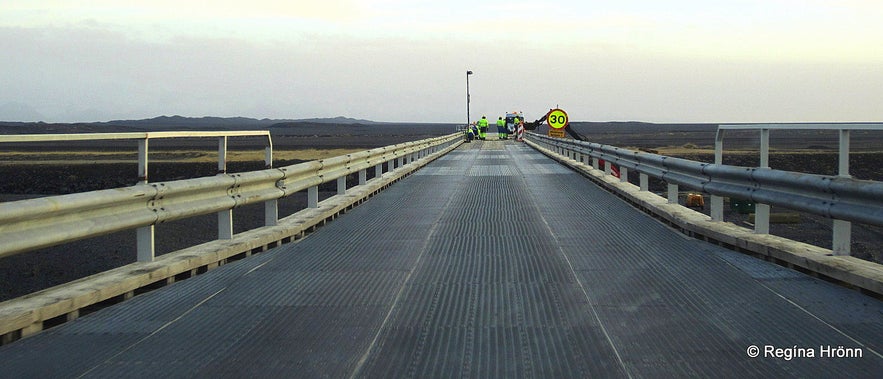 The one-lane bridge by Núpsvötn was under construction during our trip
The one-lane bridge by Núpsvötn was under construction during our trip
There was an absolutely heartbreaking accident recently when 2 British families somehow managed to turn their jeep and crash into the railing of the one-line bridge by Núpsvötn and drive on top of it until the jeep collapsed from the bridge and crashed down onto the sandbank beneath.
There were 3 fatalities; both wifes got killed and a baby :( We don't know what happened and the driver was not speeding.
Iceland crash: Three British people including a child killed
We cannot have another accident like this, this was the absolute worst, so please be very careful and never speed on one-lane bridges. The car arriving first at the bridge has the right of way.
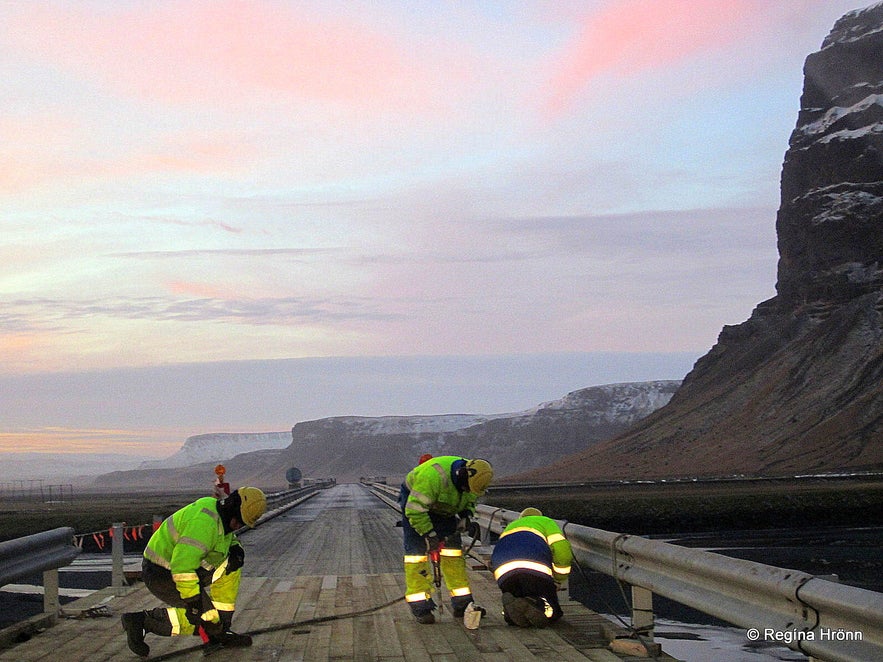
The next day, on our way back to Reykjavík
Shortly after the heartbreaking car accident on this bridge, there was another accident on a one-lane bridge on the Golden Circle, the most popular route in Iceland, when tourists didn't realize that they were driving on a one-lane bridge and wondered why there was such a narrow space to meet the other car. The sign reads einbreið brú - a one-lane bridge.
So educate yourself before your Iceland visit about possible dangers before driving on Icelandic roads, especially in wintertime when daylight is scarce and the roads might be slippery.
How to Drive Safely in Iceland
Safe Travel- the Official Source for Safe Adventure in Iceland
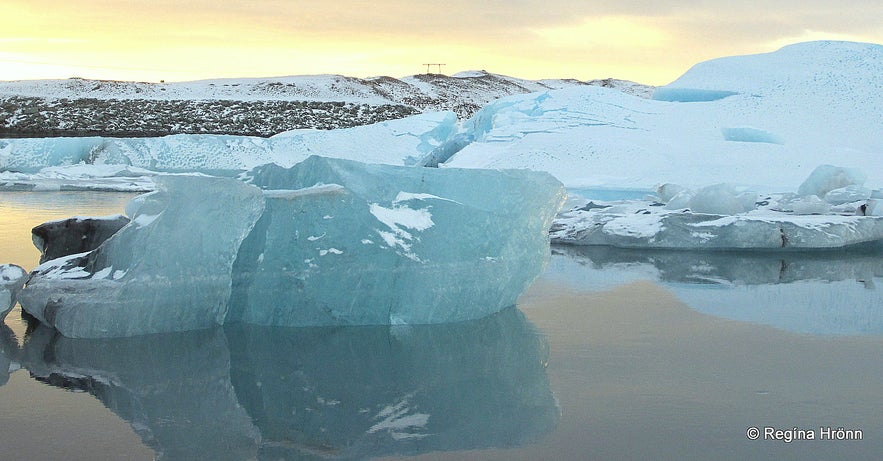
Jökulsárlón glacial lagoon
We were now approaching Skaftafell, which is a beautiful pearl of nature on the south coast.
But as wanted to see Jökulsárlón glacial lagoon in the sunshine when it is at its most beautiful, we passed Skaftafell and drove straight to the glacial lagoon, with the intention of visiting Skaftafell on the way back, given that we had enough daylight.
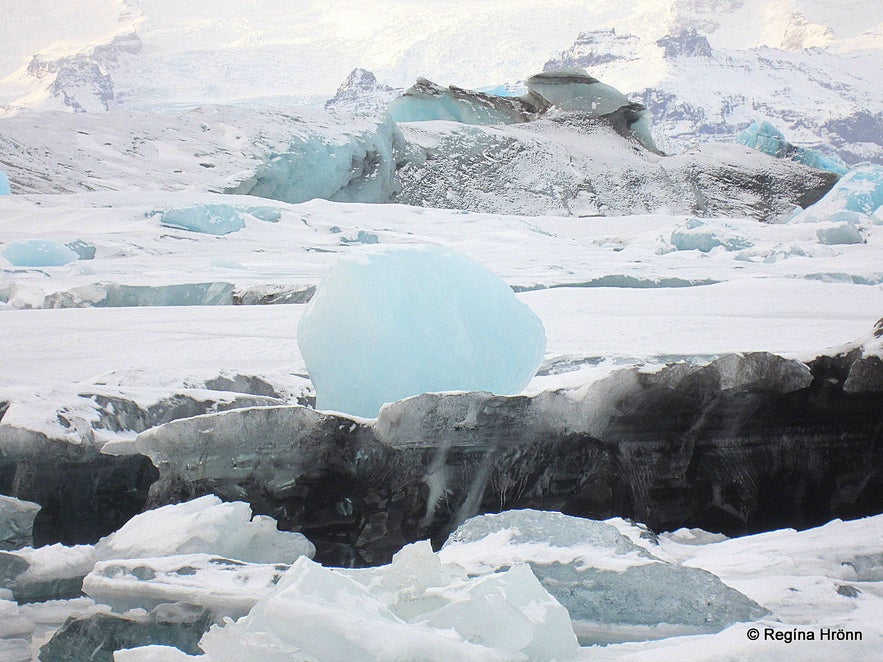
Jökulsárlón glacial lagoon
Jökulsárlón glacial lagoon has been called the Crown Jewel of Iceland and I totally agree with this title, as no matter how often I visit it I always say "WOW".
Seeing that the glacial lagoon is some 380 km away from Reykjavík, where I live, then I don't see it very often and am always in awe when it appears :)
So when the sisters said that they planned on visiting the glacial lagoon I jumped aboard and asked if they wanted me to guide them ;)
The glacial lagoon is ever-changing so you never know what to expect; one thing is for sure though that it is always breathtaking. The blue icebergs and the myriad of ice formations on the serene lagoon are out of this world.
And during our winter visit, there was snow on the icebergs, it looked quite different from what I had seen during my summer visits.
The lagoon was so calm and the surroundings were quite surreal, as you can see in the video I shot at the glacial lagoon.
Jökulsárlón glacial lagoon was very beautiful in the low winter sun and even though I only had a small camera back then, then I think the photos turned out quite nice.

Jökulsárlón glacial lagoon
The most beautiful photos I have seen of Iceland are from the glacial lagoon and the Breiðamerkursandur sparkling ice chunks, and with more professional cameras the photos turn out amazing.
I have joined an amphibious boat tour on the glacial lagoon and wrote about it in my travel-blog Jökulsárlón Glacial Lagoon - a Tour of the Jewels of the South Coast of Iceland.
The icebergs calf off Breiðamerkurjökull glacier, which is a part of the massive Vatnajökull glacier, Europe's largest ice cap by volume, and get slowly carried out to sea; under the bridge and down to Breiðamerkursandur beach.

Sparkling ice chunks at Jökulsárlón glacial lagoon
The Breiðamerkursandur ice diamond beach didn't have that name back then and very few people visited it.
I always went down to Breiðamerkursandur or Eystri and Vestri-Fellsfjara, which is the name of this beach, as I Ioved seeing the ice chunks glittering on the beach.
I see that Breiðamerkursandur has been marked the Diamond beach on Google maps, but it should say Breiðamerkursandur, as a made-up name should not replace the old Icelandic topographical name.
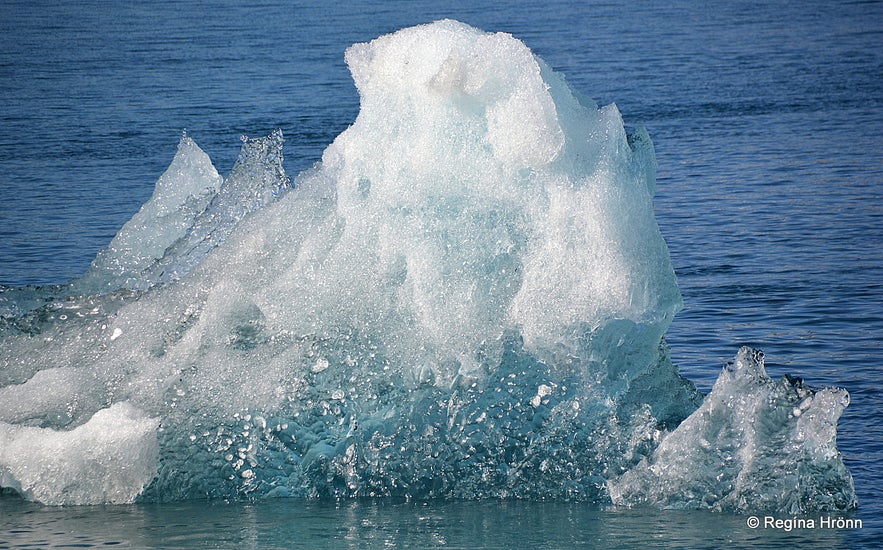 The icebergs are polished by the waves
The icebergs are polished by the waves
It wasn't until a fellow blogger came up with this name that Guide to Iceland decided on checking if the name would catch on.
And as I had loads of photos of this beach, I took on the task of writing the first travel-blog with the name Diamond beach in the title.
It caught on for sure and now all the tourists visiting it call it Diamond Beach.
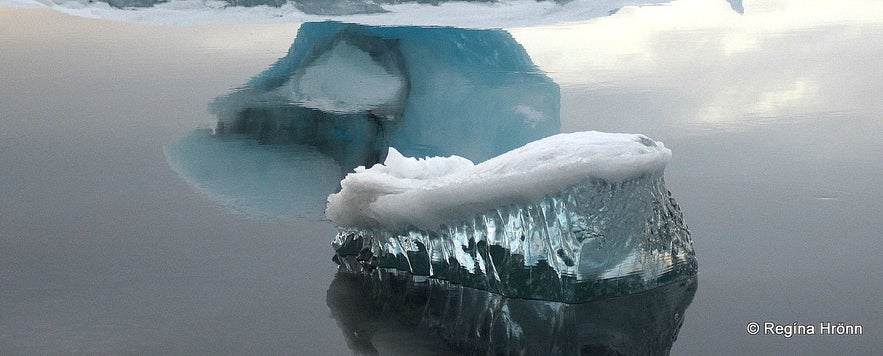
Jökulsárlón glacial lagoon
Here is the travel-blog I wrote a couple of years ago:
Iceland Has Got a sparkling Ice Diamond Beach on Breiðamerkursandur!
The name is a tourist name though as when asked most Icelanders have no idea where Demantaströndin, the Icelandic term for the Diamond Beach, is. We Icelanders always refer to it as Breiðamerkursandur or Fellsfjara.
I think it is a lovely English nickname for this beach, as here the ice turns into sparkling ice diamonds.
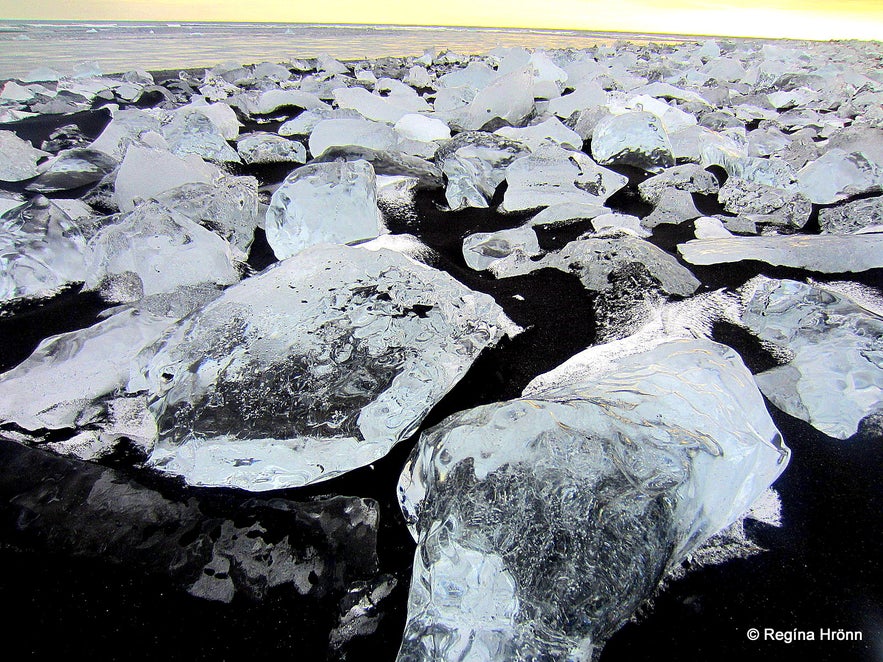
Sparkling ice covered the beach
The icebergs float from the glacial lagoon and into the sea, where they get polished by the waves and some of them get washed ashore.
On the day we visited parts of the black beach were covered in ice.
The appearance of the polished ice chunks on Breiðamerkursandur varies to a great degree, so you never know what to expect.

Leaning against a big, blue chunk of ice on the beach - ask the photographer to keep an eye on the waves
Sometimes there are small chunks of ice covering the beach and sometimes there are big powdery blue chunks of ice, against which you can lean and have your photo taken.
The photo above is my first photo in the series "Chilling on an iceberg" and I have got many such photos by now.
A word of warning: always keep your feet on the sand and never crawl up on an iceberg, and never go close to the waves. The waves can come in unexpectedly leaving you stranded on an iceberg. You can get carried out to sea this way, so this is a real danger.
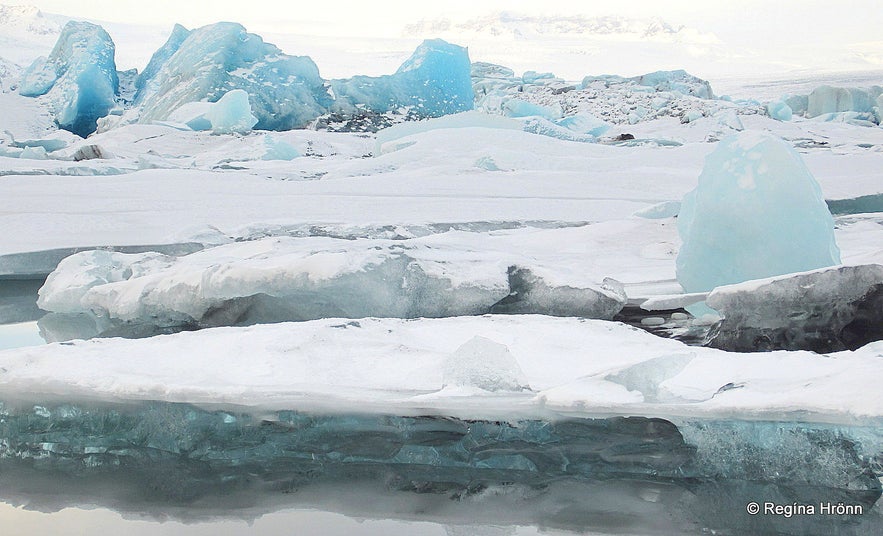
Jökulsárlón glacial lagoon
We are here right by the open ice-cold Atlantic ocean and not on a playground, even though I feel like a child when visiting the Breiðamerkursandur beach.
I warn you against this as recently we have had two such incidences where people got stuck on icebergs:
Grandma almost lost at sea on Iceland’s Diamond Beach
Tourist trapped on an iceberg on Diamond Beach
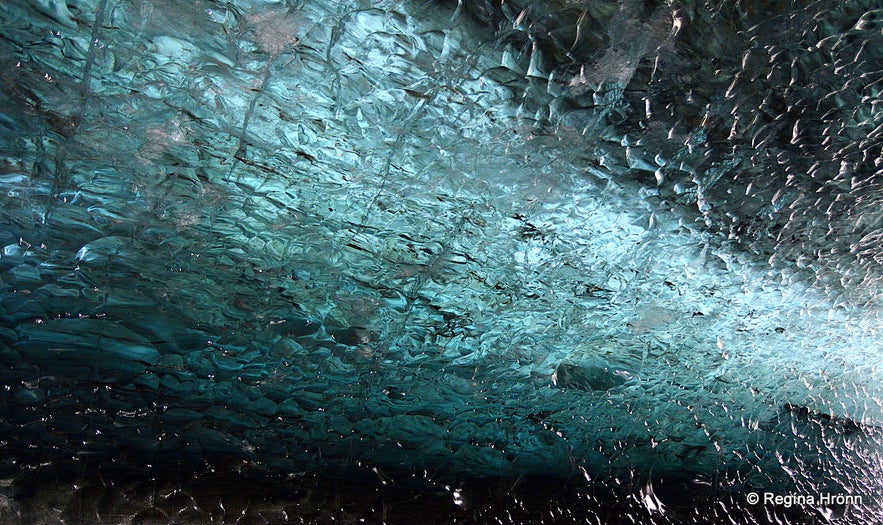 A blue ceiling inside an ice cave in Breiðamerkurjökull glacier
A blue ceiling inside an ice cave in Breiðamerkurjökull glacier
So enjoy this extraordinary beach and get some beautiful photos, while always being aware of the dangers here. And never turn your back on the waves.
What is a very popular addition now, and wasn't back when we were visiting, are the ice caves, which are a major attraction in wintertime.
The ice caves can be visited from November until the end of March weather permitting.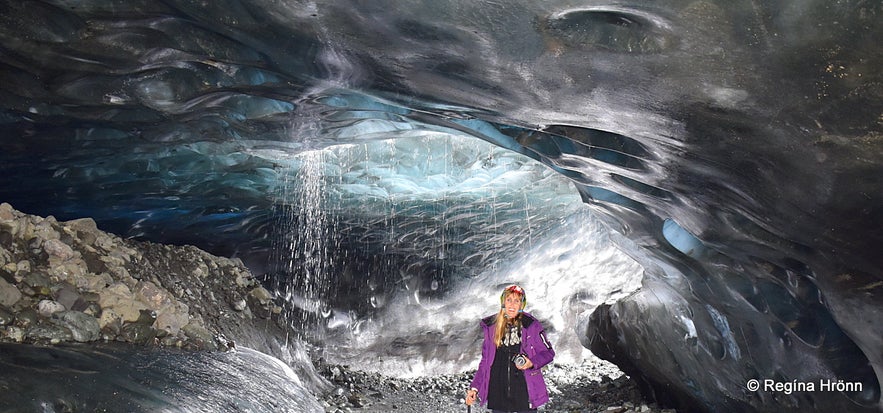 Inside an ice cave in Breiðamerkurjökull glacier
Inside an ice cave in Breiðamerkurjökull glacier
I have visited 3 of the ice caves in the Vatnajökull glacier on guided tours and they are quite extraordinary, the blue dome of the ice enveloped me and it was like being transferred to another world.
You can see more photos in my travel-blog on the ice cave in Breiðarmerkurjökull glacier:
A Sapphire Blue Crystal Ice Cave in Vatnajökull Glacier in South-Iceland
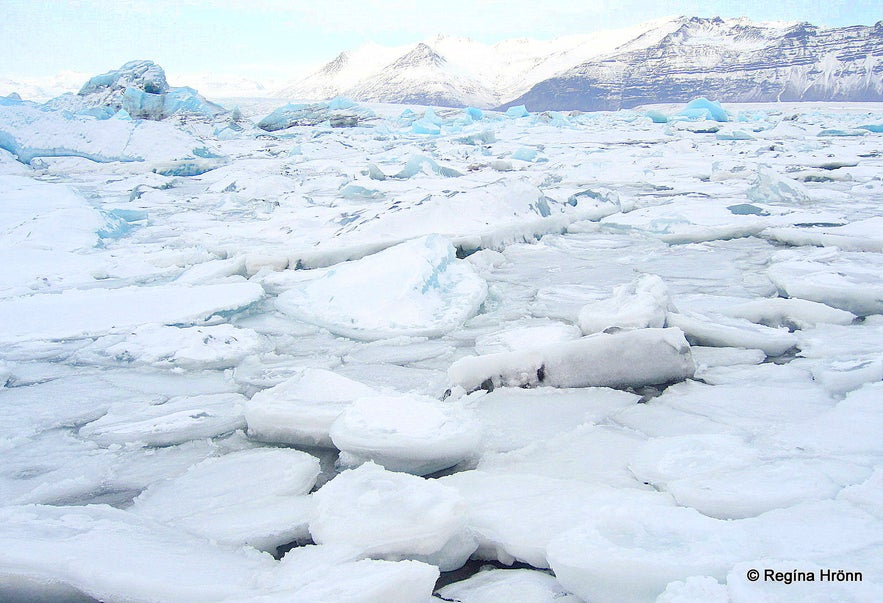
Jökulsárlón glacial lagoon
On our way back we visited Skaftafell and hiked to the edge of Skaftafellsjökull glacier. It is a 3.7 km hike, the main part of it on even ground.
We spent an hour back and forth on this hike and it was well worth it as being so close to the glacier is amazing. We caught the last pink rays of the winter sun.
Don't get too close though and never go unaccompanied on a glacier as it is moving, and in the ice deadly crevasses are hidden. There are guided tours on the glacier, where experienced glacier guides show you around.
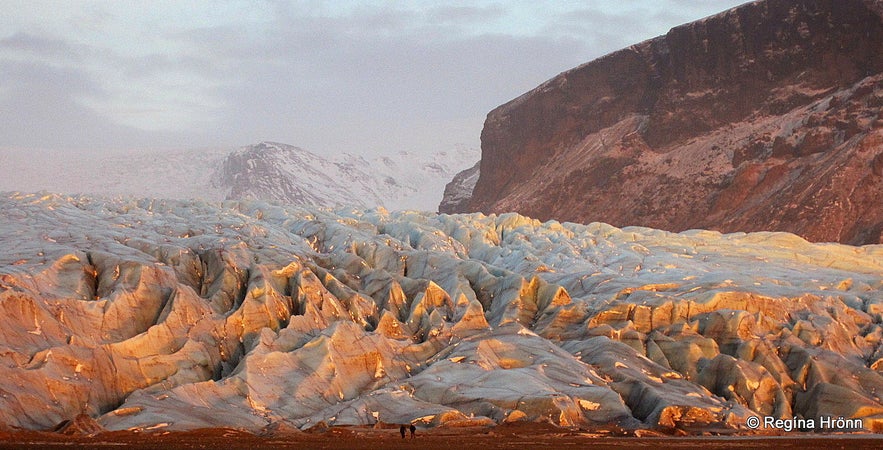
Skaftafellsjökull glacier in the winter sun
We stayed at a safe distance and took photos and admired the glacier.
Everything was frozen solid and the small waterfall, which trickles down the rock, had turned into icicles and pretty ice figures.
In my travel-blog on Skaftafell, you can see summer photos from this beautiful place:
Svartifoss & other astonishing Attractions in Skaftafell in South-Iceland
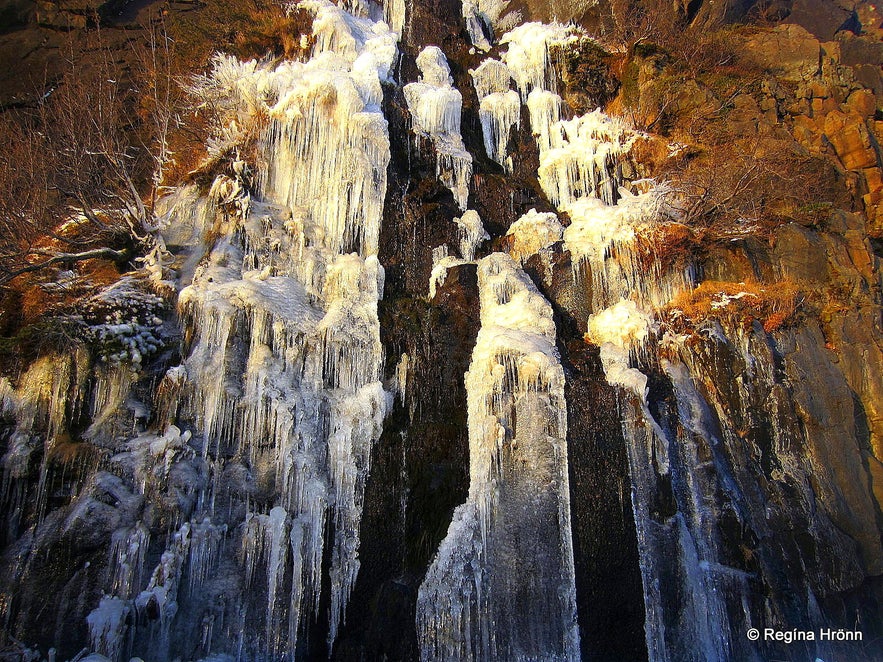
The frozen waterfall. Isn't it pretty?
What else can I tell you? Blizzards, poor visibility, strong winds, all this can happen in Iceland in wintertime. Very often we have beautiful weather, still with Northern Lights, sometimes we have plus temperatures and the roads are clear, and sometimes it is a pure winter storm.
But this said, then visiting Iceland in wintertime can be a beautiful experience.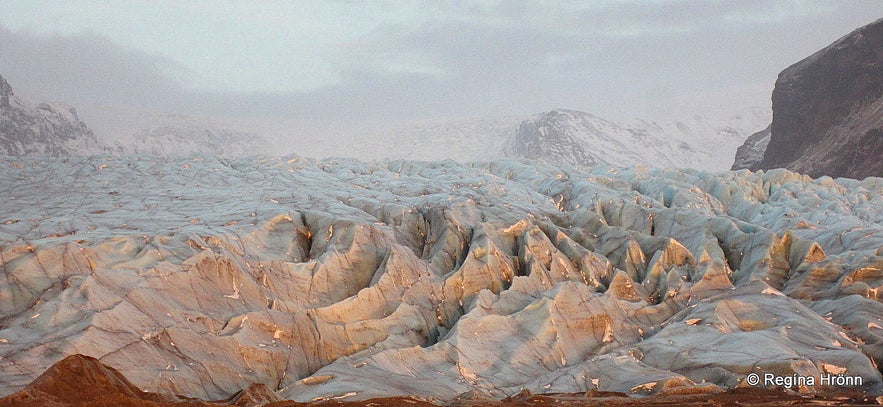
The sun was setting and the pink hue slowly faded until the glacier turned light blue
We now returned back to Reykjavík and stopped in very few places on the way as it was getting so dark.
Ours was a lovely trip, even though we had freezing temperatures and wind, and our face was red and frozen most of the time.
Dressing in layers is necessary in Iceland in wintertime. Woolen gloves, a scarf, and a hat, woolen socks, a down parka is also always nice.
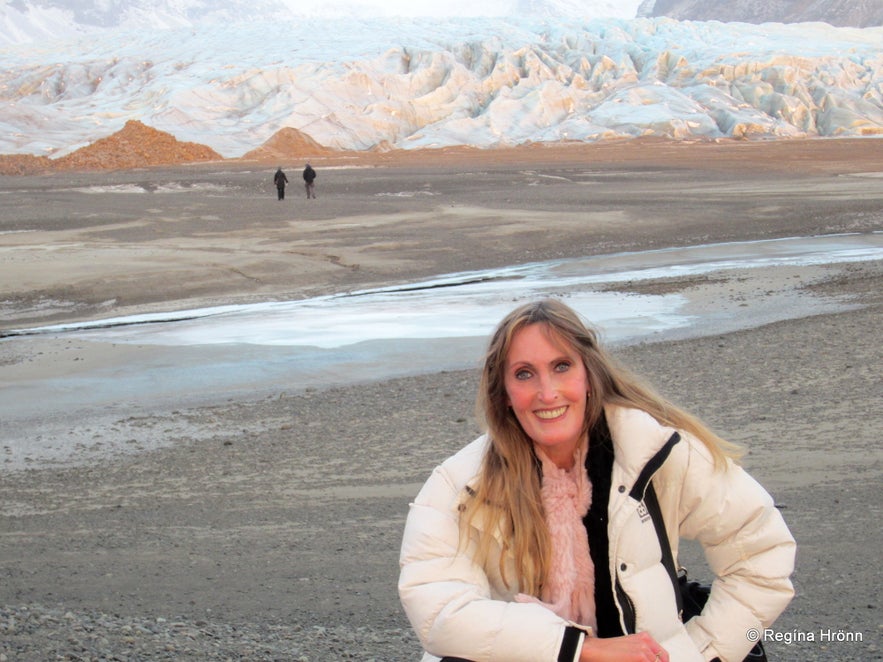 Frozen and red in the face in -10 degrees C and wind at Skaftafell ;)
Frozen and red in the face in -10 degrees C and wind at Skaftafell ;)
Always check the weather forecast before taking off, just to make sure that it will be safe to travel. Never drive if a blizzard is forecasted. This is crucial, so you won't get stuck in your car somewhere along the way.
And never ever pass an impassable sign, as it is not put up unless it is absolutely necessary; you don't want to get stuck somewhere in the snow in a winter blizzard.
Also, check the webpage of the Icelandic Roads Administration road.is before you start your journey.
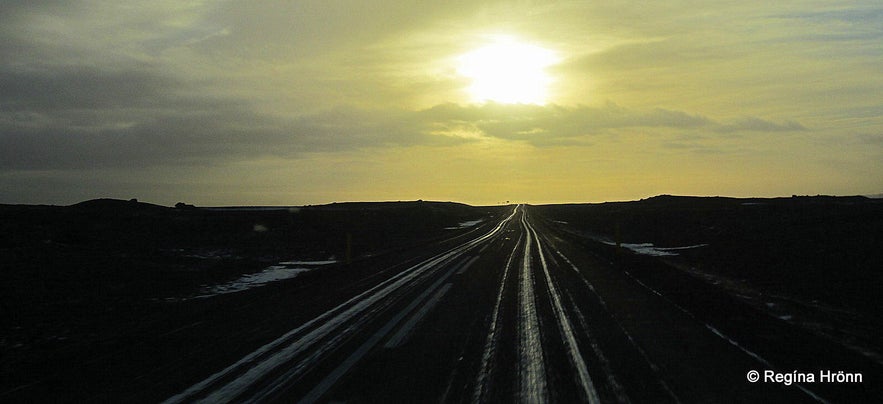
Driving back to Reykjavík
Some tourists think the impassable sign is a suggestion, which it is for sure not, and have passed it and got stuck in heaps of snow and had to be rescued. Nobody wants to experience that, so never take any risks.
The locals know when closures are needed and we want to keep our foreign visitors safe.
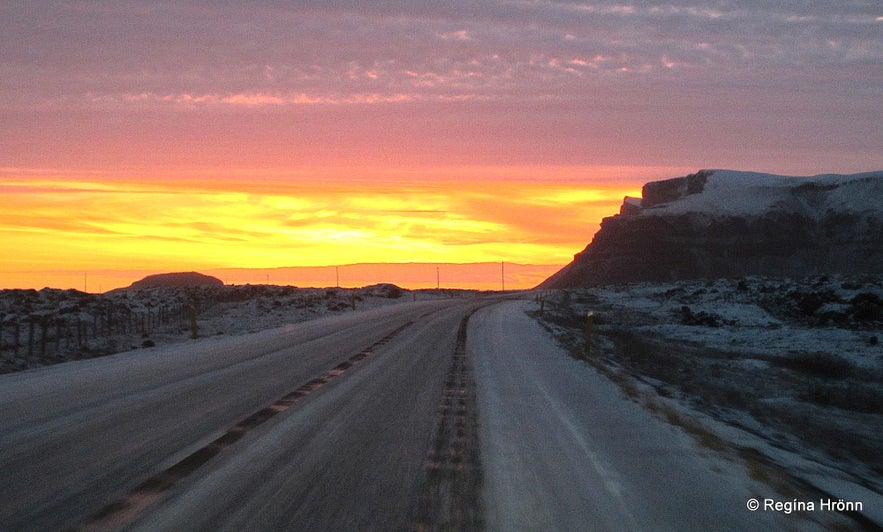 The sunset was beautiful, but no fun driving in the darkness on these icy roads
The sunset was beautiful, but no fun driving in the darkness on these icy roads
I have been stuck in a car in the middle of the street during a blizzard in Reykjavík, with zero visibility, and it was no fun.
Let alone being stuck somewhere in the middle of nowhere! For one your exhaust can get blocked if you try to stay warm by not turning off the engine.
To reach this area you can either rent a car in Reykjavík or join a guided tour to Jökulsárlón glacial lagoon.
Have a lovely winter visit to Iceland and stay safe :)
Autres blogs susceptibles de vous intéresser
Mystérieuse Islande
Je me suis longtemps demandé pourquoi j’aimais tant cette île rocheuse et mystérieuse, souvent sombre, tempétueuse... secrète ! C’est peut-être justement pour cette raison – un lieu unique ayant toEn savoir plusPlongée à la faille de Silfra
En octobre dernier, j'ai eu la chance de tester une session snorkeling à Silfra en Islande ! Cette expérience était magnifique ! Je pense que c'est mon activité préférée avec la visite d'une grottEn savoir plusCe qu’on ne vous dit pas avant un voyage en Islande
Vous partez en voyage en Islande ? Vous avez sûrement déjà épluché les forums, guides et autres sites de voyage, réservé votre vol et organisé votre circuit ? Parfait, parfait. Mais avant de savourerEn savoir plus

Téléchargez la plus grande plateforme de voyage d'Islande sur votre téléphone pour gérer l'intégralité de votre voyage au même endroit
Scannez ce code QR avec l'appareil photo de votre téléphone, et cliquez sur le lien apparaissant pour avoir la plus grande plateforme de voyage d'Islande à portée de main. Ajoutez votre numéro de téléphone ou votre adresse e-mail pour recevoir un SMS ou un e-mail avec le lien de téléchargement.















